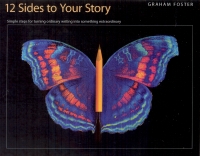| ________________
CM . . .
. Volume XVI Number 19. . . .January 22, 2010 
 |
12 Sides to Your Story: Simple Steps for Turning Ordinary Writing into Something Extraordinary.
Graham Foster.
Markham, ON: Pembroke, 2009.
32 pp., stapled, $12.95.
ISBN 978-1-55138-238-8.
Subject Headings:
English language-Composition and exercises-Study and teaching (Elementary).
English language-Composition and exercises-Study and teaching (Secondary).
Professional: Grades 4-10 & Student Resource: Grades 7-10.
Review by Betty Klassen.
*** /4
|
| |
|

excerpt:
Story endings often illustrate what has changed in the main character's life. Sometimes story endings show how the main character has made someone else's life different. In focusing on what is different in a character's life, writers use endings to imply a theme, a new understanding or insight for the reader.
While all of the story's elements—conflict, rising action, and resolution—relate to the theme, it is the ending that leaves the reader with the most powerful suggestion of the theme.
When you read your favourite published writers, check out how they use story endings to suggest a theme. You will notice that they show what is different by using techniques like these:
Conclude with a surprising twist. The "something different" is the difference between what is expected and what occurs –– a form of irony.
Example: A little girl is lost at the carnival. Her frantic mother searches everywhere and seeks volunteers to help. After an hour, the mother finds her little girl sitting under a tree eating an ice-cream cone.
"Mommy, I'm so glad they found you!" the little girl shouted.
"What do you mean, found ME?"
"Mommy, I went to get my ice-cream. Too bad you got lost."
Graham Foster has written a helpful, short flipbook that outlines 12 strategies to support student writers in the process of improving their narrative story writing. He addresses the student, but 12 Sides to Your Story could also easily be used as a teacher resource to outline the structure of a unit on story writing.
The 12 "sides" presented on page two are: writing variables for stories; story beginnings that command attention; endings that point to theme; journal writing focussed on conflict; showing, not telling; planning strategies for story writing; sentence power; words as illustrations; writing with a distinctive voice; usage and spelling; revision that works; and sharing your story.
Novice teachers would benefit from the focus provided by the 12 "sides" or facets of story writing. Each "side" could be a lesson plan to support students in improving their writing. All teachers could use this booklet as a student resource to support the students' individual assessment of their own writing. Foster has written a page addressed to teachers and the use of this resource to assist students in setting and achieving writing goals and to support teachers in differentiating instruction. He suggests six books of story collections and two magazines as additional resources, and he uses examples of student writing in his explanations. The success of using this booklet strongly depends on students' having examples of effective story writing to examine for evidence of the strategies.
A Flesch-Kincaid grade level analysis positions this booklet at a mid grade 7 reading level. Care would need to be taken to ensure that students had the prerequisite knowledge Foster assumes, such as, within the discussion of "sentence power," students would need to have a working knowledge of basic sentence types—declarative, exclamatory, interrogative, and imperative, as well as participles, prepositions and subordinate clauses. Students would also need to be able to assess their own stories according to basic story elements. Foster also assumes that the strategies he suggests will "relate directly to rubrics you and your teacher probably use to assess your writing."
The user-friendly format includes a table of contents and an index, as well as tabbed pages with the topic headings on a red background. Three reproducible pages provide students with a Strategy Checklist, Personal Writing Goals, and a Story Frame. Each strategy is briefly explained in the format you have read in the excerpt of "voice" included above, examples of student work are provided, and an Action Plan concludes the section. The Action Plans all follow the same format guiding students to reread a published story to look for evidence of the strategy, to revise one of their own stories using the strategy, and, if this is not necessary, to reinforce their knowledge by identifying their appropriate use of the strategy within their own writing. Some strategies also include an idea or two to follow when writing a story in a test situation. Strategic colour blocking assists the reader to find ideas easily: actions plans are always in a lilac box, examples from other writing in green and cross-references to other strategies in blue.
Graham Foster has worked as a language arts supervisor for a school board and presently works as a private consultant, writer and workshop leader. This booklet is evidence of his specialization of the "practical aspects of language arts instruction" and provides students and teachers with 12 concrete ideas on the teaching and writing of stories.
Recommended.
Betty Klassen teaches in the Faculty of Education in the Middle Years Program at the University of Manitoba.

To comment
on this title or this review, send mail to cm@umanitoba.ca.
Copyright © the Manitoba Library Association. Reproduction for personal
use is permitted only if this copyright notice is maintained. Any
other reproduction is prohibited without permission.
NEXT REVIEW |
TABLE OF CONTENTS FOR THIS ISSUE
- January 22, 2010.
AUTHORS |
TITLES |
MEDIA REVIEWS |
PROFILES |
BACK ISSUES |
SEARCH |
CMARCHIVE |
HOME |
